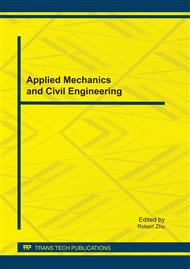p.36
p.42
p.50
p.59
p.65
p.72
p.77
p.82
p.87
Study of Destruction Mechanism of Floating-Roof Oiltank under Combustible Gaseous Explosion in a Small Scale Experiment
Abstract:
The number of accidental explosions has recently increased, and more researchers focus attention on damage mechanism and safety strategy of structures. The aim of this paper is to assess the mechanical effects of an accidental explosion of a gaseous mixture and the floating-roof oiltank dynamic response subjected to external blast wave loading. For this purpose, the research is based upon an experimental study at laboratory scale. It shows that the pressure induced by blast wave on the structures rose immediately and altered dynamically. The top of the oiltank surface towards blast loading is in a tensile state with the maximum strain. It is the vulnerable place to resist the gaseous blast loading. Meanwhile, the inner liquid could induce the compression wave, and collided with the structures of the oiltank intensively. Compared with the blast wave pressure on the front, the back wall pressure transmitted by liquid collision had the same order of magnitude and longer actuation duration than the former.
Info:
Periodical:
Pages:
65-71
Citation:
Online since:
October 2011
Authors:
Price:
Сopyright:
© 2012 Trans Tech Publications Ltd. All Rights Reserved
Share:
Citation:


